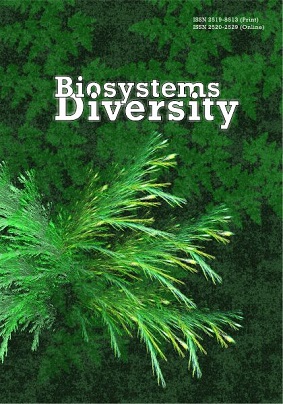Dynamics of indices of metabolism in muscle tissue, liver and gonads of Abramis brama in different periods of the annual cycle
Dynamics of indices of metabolism in muscle tissue, liver and gonads of Abramis brama in different periods of the annual cycle
Author(s): A. A. Payuta, E. A. FlerovaSubject(s): Health and medicine and law, Sociobiology, Environmental interactions
Published by: Дніпропетровський національний університет імені Олеся Гончара
Keywords: bream; sex; gonad maturity; condition factor; spawning;
Summary/Abstract: The aim of this research was to study the dynamics of metabolism in the body of bream Abramis brama (L.) at different periods of the annual cycle: pre-spawning, spawning, post-spawning and feeding. The object of the study was 55 male and 53 female bream aged 9–13 years, to reduce the effect of age on the studied parameters. Individuals were measured, weighed, gender was determined, gonad maturity stage, age; the condition factor and organ indices were calculated. The content of moisture, dry matter, lipids, proteins, ash and nitrogen-free extracts (NFE) in the muscles, liver and gonads of male and female bream have been analyzed. The lowest coefficients of condition factor were found in bream during the autumn feeding season, the highest in males during spawning, in females before and after spawning. In the muscle tissue of male and female bream the content of metabolic products in the feeding period and before spawning differed slightly. In the spawning period, the muscles of males exceeded the muscle tissue of females in lipid content by more than two times. In the annual cycle of the bream, the ovaries contain more protein than the testes. The bream of different sex revealed differences in the intensity of metabolic processes during the maturation of gonads: in males, energy costs are more pronounced after wintering before spawning, while in females, during spawning. The main energy reserve in the form of lipids in the annual cycle changes more significantly in the body of male bream than in females. Ovarian maturation requires more metabolite reserves than maturation of the testes, however, males have increased expenditure associated with reproductive behaviour during spawning. Therefore, the total energy contribution to reproduction may be the same for female and for male bream. Bream’s liver and muscle tissue can serve as a source of energy during food shortages and during spawning. In the annual cycle, the condition factor of bream increases due to an increase in the moisture content in the muscles.
Journal: Biosystems Diversity
- Issue Year: 28/2020
- Issue No: 2
- Page Range: 146-153
- Page Count: 8
- Language: English

